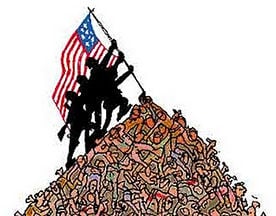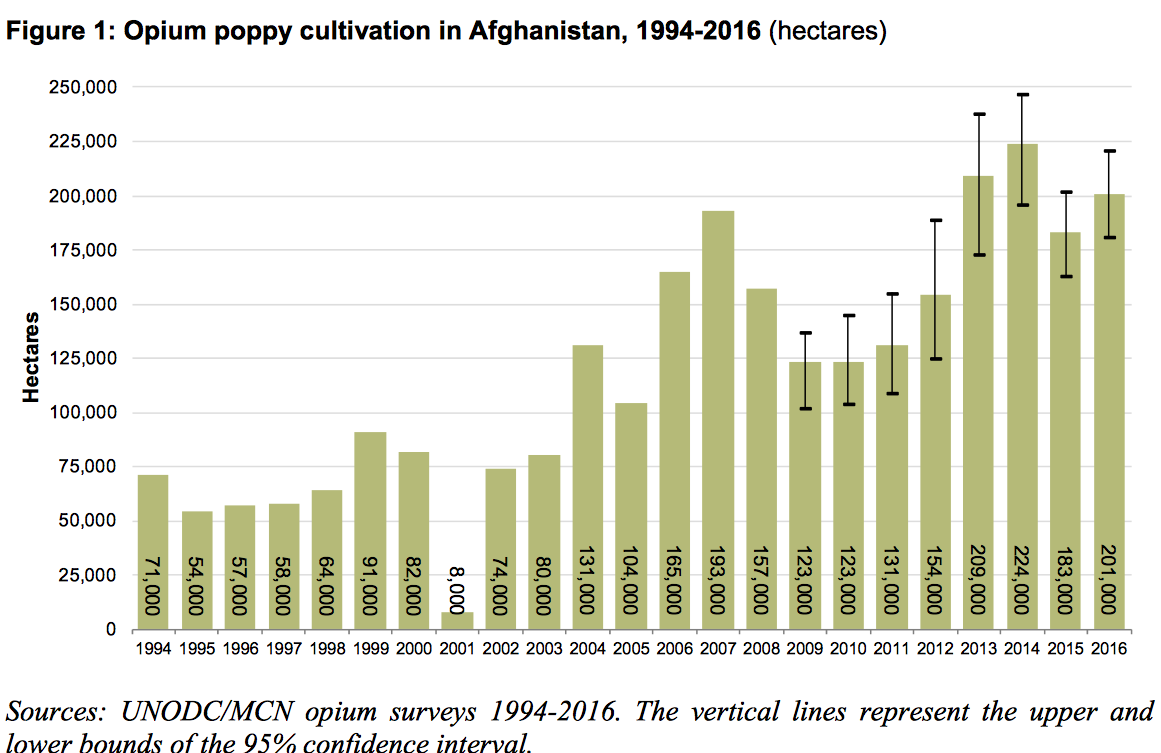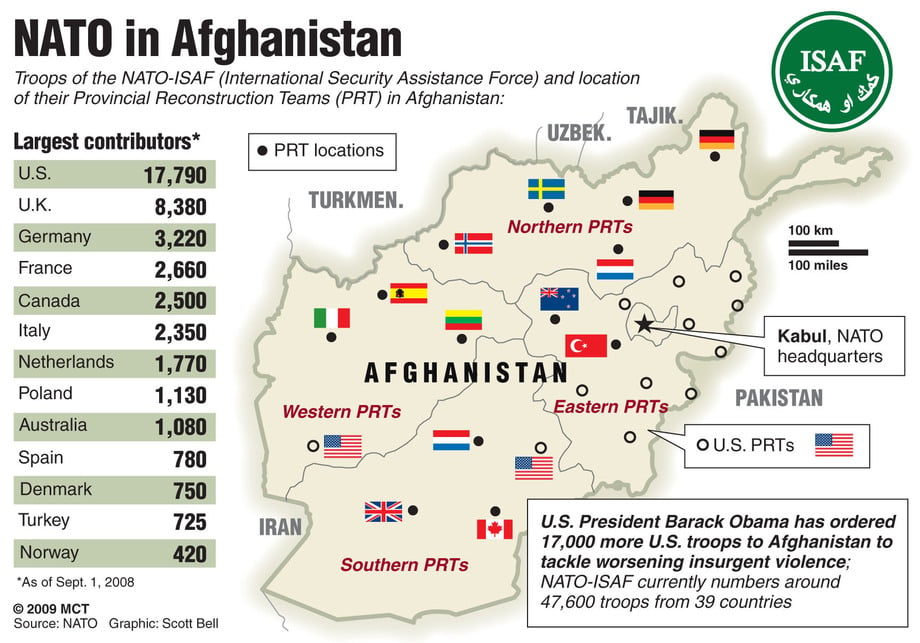The US-led Invasions and Occupation of Afghanistan and Iraq. A Comparative Analysis

Afghanistan was invaded on October 2001, unlike a usual US invasion in the month of March which marks the onset of U.S. invasion and occupation of a litany of victim nations.
The events leading to Afghanistan’s occupation adequately convinced the Americans and rest of the world thanks to the enormity of the September 11, 2001 calamity {which was blamed on Afghanistan) and the US subsequently received a green light from the most NATO members to accompany. But Iraq’s invasion was more of a hasty plot that was implemented unilaterally by the US [and the UK] and is still under fire from global observers and media.
The same parties that backed the incursion on Afghanistan stood counter to the pre-emptive, legally dubious and globally controversial US invasion of Iraq in 2003. A US resolution in November 2002 stated that Iraq was in material breach of its 1991 Gulf War ceasefire obligations relating to the possession of weapons of mass destruction.
At the time, the UN weapons inspectors, led by Hans Blix, returned to Iraq and reported increased Iraqi cooperation and disclosure of information. But Bush and Tony Blair rejected Blix’s findings and, despite failing to secure a second UN resolution authorizing the use of coercion, the US and the UK launched the invasion on March 20, 2003.
Two weeks before the invasion of Afghanistan, the underpinnings of the war on terror were laid out in President Bush’s speech to a Joint Session of Congress on 20 September 2001. Bush declared that,
“we will pursue nations that provide aid or safe haven to terrorism… Either you are with us, or you are with the terrorists… any nation that continues to harbor or support terrorism will be regarded by the US as a hostile regime”.
This established the framework for attack on a country [Afghanistan] which was accused of “sheltering terrorists” [Al-Qaeda].
Bush’s “Axis of Evil” speech in January 2002 accused Iraq, Iran and North Korea of supporting terrorism and seeking weapons of mass destruction. In 2002, the administration focused increasingly on defining the concept of a pre-emptive war on Iraq.
In the wake of the attack on both countries, the US under the installed governments reformed the economic and political laws there and wrote new constitutions. The manipulation in laws transformed both states’ economic system, only meant to adapt the economic environments to the demands of their corporate globalization policies.
In Iraq, new laws reduced taxes on all corporations by 25 per cent. The ultimate goal was to open Iraq to US oil companies.
Afghanistan’s economy is labeled by many economists as “bogus” due to its heavy dependence upon US funds. More like the US itself, the gulf between labor/lower class and rich people in Afghanistan is widening and the balance is sliding towards the rich.
The conceived poverty in Afghanistan is an evil scheme – not a natural phenomenon – to push people into the ditch of destitution and a state of inevitability to embrace extremism and take up arms for a viable armed conflict against the Afghan Government.
Aimed to throw dust into the eyes of the global audience, the Western Generals and the puppet governments’ functionaries construct false statements.
Recently, US Army General John Nicholson pointed his finger at Russia and Iran for having allegedly supported the Taliban in Afghanistan. There is a brief video clip advertised numerous times on best-selling Afghan TV channels only to deliver Afghan viewers that Russia has armed a Taliban faction in southern Helmand province.
Tajikistan recently dismissed the allegations by the US Generals over Russia’s support of the Taliban in Afghanistan.
If Russia is poised to give an account of the Helmand case, then the US should also come forward to explain the crimes committed at its hand in Afghanistan in the past sixteen years.
Whether in Iraq or Afghanistan, there is nothing to pose about the “failure of the US in the war”. The US is indeed winning everyday that is not visible for many.
Iraq’s war is relatively more in news than the protracted war of Afghanistan. The latter’s armed strife is justified by the growing foothold of the Taliban group as well as deadly suicide blasts in the capital Kabul that kill dozens each time. But for Iraq’s war, there is no longer evidence of a “fabricated” enemy to declare war on.
Opponents of the Iraq war often highlight the importance of oil when explaining why the invasion took place. Oil is the lifeblood of Iraq. It accounts for about 99% of all government revenue.
For decades before the invasion, the Industry had been in the hands of the state-owned Iraq National Oil Company which was famous for its “Arab oil for the Arabs” slogan. In September 2003, the US-led Iraqi Administration announced that foreign investment was acceptable for the rest of the economy but not for the oil sector.
Oil was most plentiful in the supergiant fields of Rumaila and near Kirkuk that, in terms of profits siphoned off to occupiers, is identical to Afghanistan’s southern Helmand province that has been the heartland of poppy cultivation throughout the US invasion since 2001 and account for more than 90 per cent of the global drug trade .

The oil industry can cause or exacerbate conflict in multiple ways: competition over shipping lanes and pipelines, oil-related terrorism, petro-aggression, and resource scarcity in consumer states are all potential sources of international conflict.
In the US, public debates about the 1991 and 2003 Iraq wars, all sides focused excessively on the question of whether the US was fighting for possession of oil reserves.
The two occupied nations still host the US forces in different numbers. The justification for continued stay is described as not losing the ground to the Islamic State or Taliban; this is while around half of Afghanistan’s territory is controlled by militants.
The mainstream media often recalls the years 2011 and 2014 as worst turning points for Iraq and Afghanistan respectively when the US pulled out the forces.
The media and Western speakers rhetorically express remorse over withdrawing from Afghanistan and Iraq in these years and reassert their permanent stay mostly when the legitimacy of the US presence is questioned internationally.
In February 2018, Pentagon and State Department officials said that the US troops can stay in Iraq and Syria for indefinite period of time. While the US military’s footing in Afghanistan and Iraq has proved disastrous, it has encroached into Syria amid its so-called war with the ISIS.
Days after the US’s announcement of stay, Iraq’s parliament demanded the government to set a timeline for the withdrawal of foreign troops stationed in the country to “help fight Islamic State”. This is something the US doesn’t want and proactively seek to fabricate new threats.
Iraq’s parliament could at least daringly pronounce that the US forces should leave, yet such a stance is far off the possibility in Afghanistan’s parliament or other powerful institutions as the US’s presence is deemed legalized by almost all Afghans.
This comes as following the ISIS defeat last year, the (former) US Secretary of State Rex Tillerson said in October 2017 that American forces would remain in Iraq to fight the Islamic State group, even if the government in Baghdad requests the US leave. The US is well predictive of the future events so that it already conveys its message to target folks.
In Afghanistan, no drastic need is seen for the US Administration to increase the number of troops unless new war policies require it to multiply the soldiers. However, the deadly bombings during 2017, mostly in Kabul, have frequently been picked up by the US officials to justify the influx of fresh batches of reinforcements as well as a longer stay of US forces.
Studies show that nearly half million Iraqis have died between 2003 and 2013, followed by the even more fatal years of fierce battle against the Islamic State that signifies the time with the highest death toll. Only since February 2018, more than 900 civilians have died in the war.
Afghan civilians bombed from the ground and the air by both Taliban and international forces find nowhere to hide. The UNAMA and news reports each time emerge with higher number of civilian causalities. The civilians here are not always falling prey in the crossfire between Afghan/international forces and militants or mistakenly air raided by drone or helicopters; they are intentionally struck with a variety of arms.
In the modern war’s definition, if there is no enough causality in a war, it may not amount to a conflict that may require the stationing of as much troops and bases as it exists today in Afghanistan.
In 2016, the US-based Brown University’s comprehensive study placed the overall number of Afghan death toll between 2001 and 2016 at 111,000 people and injured at 116,000 people.


